Many have tried to predict the future of alternative energy in America. However, claims that wind, solar, or other forms of renewable energy could replace fossil fuels fall ludicrously short. A realistic, and yet critically informed and innovative approach is needed that takes full, rational stock of the facts. The way for America to regain its role as a global energy leader is through hydropower. Hydropower is emerging as the only feasible solution that would provide outcomes of scale, competitive pricing, and actual environmental sustainability towards the elements of the Earth and humanity. Our bet is on a global innovator such as Diamond Infrastructure Development, Inc. to deliver this breakthrough promise of real renewable energy for generations to come.
The Farce of Wind and Solar “Renewables”
A quick look at data shows that currently, hydrocarbons supply over 60% of world energy, and since 1995 total world energy production has nearly doubled (~95%). Fossil fuels supply by far the majority of energy usage, with the 29% remaining renewable energy being broken down into 6% wind, 17% hydropower, 3% solar, and 3% others.
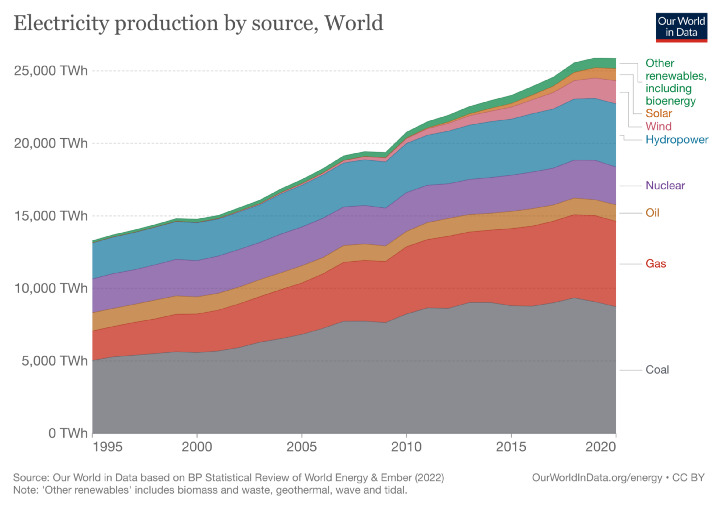
As we know, gas prices continue to rise every day. As The Guardian notes, a prolonged war with Russia’s invasion of Ukraine would take prices above the all-time high, adding to inflation and the cost-of-living crisis already underway. Although Russia is not America’s top fossil fuel supplier, this unrest affects the interconnected global supply commodities market. “There’s been a de-facto ban on Russian oil since the invasion began, with most of the country’s supply sitting unsold. So, investors are essentially pricing oil as if Russia’s supply isn’t available at all. And again, less supply = higher prices.”
Though fossil fuels will continue to be the leading energy source globally even as prices rise, renewable sources are simply not cutting it as an alternative. As many journalists and energy and technology experts have noted, wind and solar energy are not feasible on any large scale, and have a lasting harmful environmental impact on the planet.
As the widely regarded academic report, “Renewable Energy: Too Little, Too Late?” of Monash University states, “RE [Renewable Energy] sources can be divided into two groups: those that are continuously available, and those that are only intermittently available. RE is often popularly seen as the reverse of fossil fuels: it is available in unlimited supply and has no negative environmental impacts. [But] much of the good press RE gets is because of its very limited use compared with total energy…Large-scale RE is not without its own serious environmental problems; [and] RE will take many decades to provide the quantities of primary energy that a ‘business-as-usual’ world demands. In fact, it may never be able to provide this amount.”
Marginal Efficiencies
In reality, solar and wind facilities suffer from a very high capacity cost per megawatt, low reliability, and deficient capacity factors, which result in what the industry states as low avoided emissions and low avoided energy cost per dollar invested. In other words, the actual price point for implementing these technologies is more expensive and burdens taxpayers, let alone producing the product (i.e., its supply chain) creates a much greater carbon footprint than its deployment and ongoing operations, but it still all belongs to the product. This seems to get lost during the conversation of “cleaner” energy alternatives.
Take wind turbines. Wind turbines have a low efficiency rate and produce little or no power around 60% of the time and to date, have no means of decomposing. When taking account of such low capacity factors, it can be seen that onshore wind farms need over 247,000 acres of land to produce the equivalent of a typical 3 GW power plant operating continuously. However, the space claim above does not include the space required for storing 70% of the electricity production for when the wind doesn’t blow.
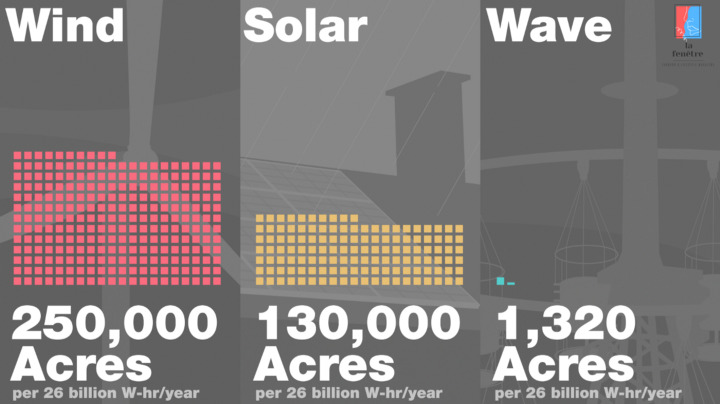
The materials used for making the turbine blades and other components are not yet totally recyclable. Therefore, when they get disposed of, they produce a large amount of carbon emissions for the process of cutting, crushing, grinding, and trucking to landfills, as necessary to reduce the volume as much as possible to economize landfill utilization, again adding to the overall carbon footprint.
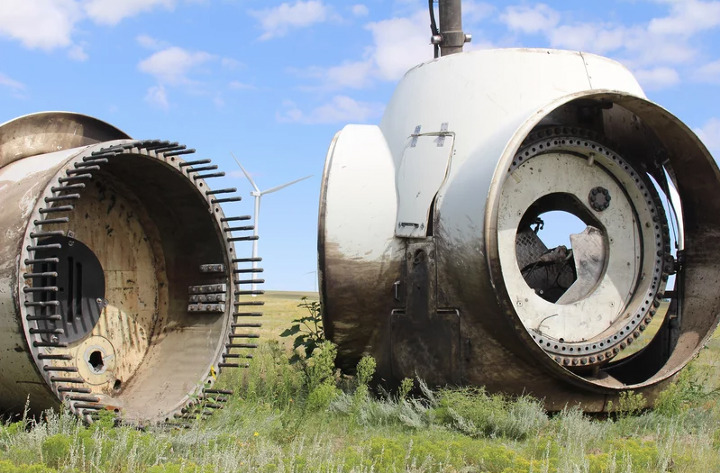
Most solar panels used today have efficiencies between 15% and 20% and leach toxic chemicals as they age, while they are being regularly cleaned with large amounts of fresh water, again all adding to their overall carbon footprint. They also offer the disadvantage of open space required to produce energy. It takes over 120,000 acres of land to produce the equivalent of a typical 3 GW power plant operating continuously, as used in the above example. Advanced solar cells only have an efficiency of 25%, while household solar cells are at 19% efficiency.
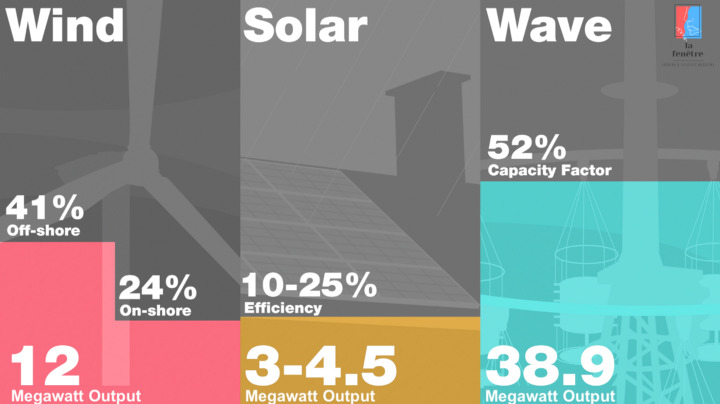
For either onshore wind, or solar power, such large tracts of land, where natural resources exist in commercial quantity in conjunction with proximity to load centers, “are not”, widely available.
Compensating for Deficiencies
In Mark P. Mills extensive report, “The New Energy Economy: An Exercise in Magical Thinking,” states, “Cost models for wind and solar assume, respectively, 41 percent and 29 percent capacity factors (i.e., how often they produce electricity). Real-world data reveal as much as ten percentage points less for both. That translates into $3 million less energy produced than assumed over a 20-year life of a 2-MW $3 million wind turbine.”
The costs of deficiencies of the machine and resources, as noted above, are only a portion of the added costs in using these technologies. “In order to compensate for episodic wind/solar output, U.S. utilities are using oil- and gas-burning reciprocating engines (big cruise-ship-like diesels); three times as many have been added to the grid since 2000 as in the 50 years prior to that.” This application of fossil-fired electricity generation is in the category of “peak-shaving” power plants which are far more costly to operate than using the conventional full-scale/full-time baseload power plants. These added costs can drive increases that exceed 50% of the normal rates.
Dependence on Subsidies
Government subsidies and incentives are hiding these actual added costs incurred by the use of wind turbines. In China, the world’s largest producer of wind and solar energy, in order to pay the subsidies for these renewable energy projects, there is now a total debt of $42 billion and growing.
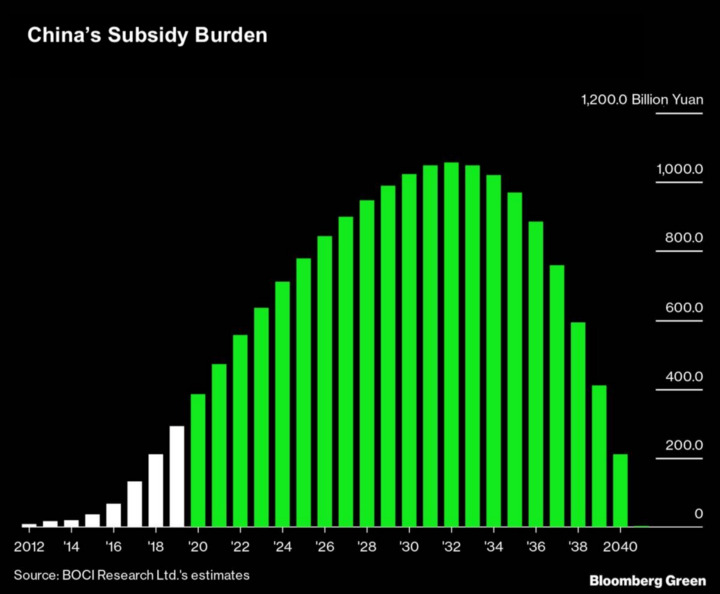
In the US, according to Congressional Budget Office testimony in 2016, an estimated $10.9 billion in tax preferences was directed toward renewable energy.
The proposed Build Back Better Framework debated in the US Congress provides for $320 billion in Clean Energy Expanded Tax Credits over 10 years. Some members of Congress requested to review the score from the Congressional Budget Office (CBO) and when the score was released on November 18, 2021, it was seen that the bill would increase the budget deficit by $367 billion over ten years.
So, China’s claim of being the world’s largest producer of wind will be answered by the US taking the title of the having the world’s largest wind power induced debt. And no, those solar panels being offered “for free” in the media advertisements are not free at all. They are paid for using your tax dollars, whether you actually allow them to be installed on your home or not.
Environmental, Geopolitical, and Social Impact
But even more alarming, are the rare earth materials necessary in the creation of these energy sources, from batteries to wind turbines and solar panels. A battery-centric grid and car world means mining gigatons more of the earth to access lithium, copper, nickel, graphite, rare earths, cobalt, etc. — and using millions of tons of oil and coal both in mining and to fabricate metals and concrete. It takes the energy equivalent of 100 barrels of oil to fabricate a quantity of batteries that can store the energy equivalent of a single barrel of oil.
As the LA Times reports in their article “The Hidden Costs of China’s Rare Earth Supply Chain,” “Rare earth is a group of 17 elements, sometimes found in minerals containing uranium, that are critical to high-tech products including smartphones, wind turbines, electric cars and military equipment such as missile systems.” They are called “rare” not because they are necessarily hard to find, but because the extraction process is expensive and toxic.

Rare earth elements are considered “strategic resources” because they interact directly with business and governments’ policy interventions (Science Direct). China accounted for about 71% of the world’s rare-earth output in 2019, and supplied 80% of U.S. rare-earth imports from 2014 to 2017, according to the U.S. Geological Survey. Experts believe illegal mines in China are providing more through the black market.

“China dominates global battery production with its grid 70 percent coal-fueled: EVs using Chinese batteries will create more carbon dioxide than saved by replacing oil-burning engines. Many proposals for new solar technologies call for rare materials, which alone could limit extensive commercialization.”
As numerous reports in the past decade have concluded, there are severe human rights issues and abuses relating to rare earth mining sites. Cobalt, a key rare earth component, has been the subject of investigations by Amnesty International and many others. More than 70% of the world’s cobalt is produced in the Democratic Republic of the Congo (DRC) and 15 to 30 percent of the Congolese cobalt is produced by artisanal and small-scale mining (ASM.) “Child labor, fatal accidents, and violent clashes between artisanal miners and security personnel of large mining firms are recurrent.”

There is now a total dependency on China’s supply chain in that raw materials are not made available, buyers must buy the physical component (batteries, magnets, etc.) that has already been processed in China. “Few other countries are willing to copy China’s low-cost, high-pollution version of rare-earth processing,” reports LA Times.
What is the Future of Energy in America?
To secure the future of energy in America, we must reclaim our place as a global leader in innovation and address the plethora of issues outlined above. The future of energy in America must not rely on inhumane mining benefitting China’s economy and geopolitical control, let alone polluting our world. This Future must not create soaring debt in order to subsidize systems that simply do not supply adequate energy. The future of energy in America will mean leading the charge for a new global movement that is truly sustainable, replicable, and would offer a wave of new jobs and a robust new energy economy. The future of energy lies in innovation and diversity, such as tapping abundant hydropower found in current, tidal, and wave energy. Where global wave energy is the most abundant and untapped resource to date.
True Sustainability of Scale: Hydropower
Hydropower is by far the largest source of renewable electricity and the third-largest after coal and gas. In 2021, hydroelectricity accounted for about 6.3% of total U.S. utility-scale electricity generation and 31.5% of total utility-scale renewable electricity generation.
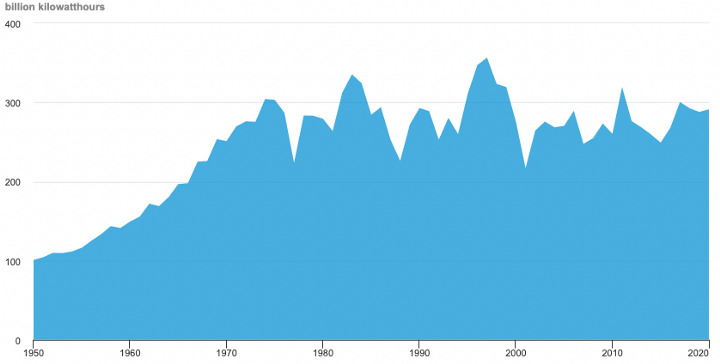
Hydropower can come in the form of Ocean energy: tidal energy (which can be either captured by barrages built across bays, or by turbines placed in tidal currents), wave energy capture devices, or ocean thermal energy conversion (OTEC) systems.
The earth’s surface is 70% water, so hydropower’s potential for supplying the world’s need for renewable energy is tremendous. Present hydropower technology has barely scratched the surface of what is possible. Wave energy is one of the most durable, impactful, and consistent forms of energy available on this planet, and its use is largely untapped by humans. In fact, US Federal Space-Exploration spending outpaces Federal Ocean spending by more than 100-to-1 in terms of dollars spent exploring outer space (2021 Federal Budget was $23.3B) versus exploring the ocean ($231.5M in 2021) and its capabilities. This allocation is spread across Ocean, Coastal and Great Lakes Research. The funding dedicated to Innovative Research and Technology was funded at only $17.8M. So, of the total ocean-related annual federal spend, only 8% goes to research and development. Compared with the Space Program, this is a factor of over 1300-to-1. The excruciating lack of investment in understanding the energy of our oceans, let alone with what’s beneath our waters, with the backdrop of astronomical annual spending on space programs, not to mention wind and solar power subsidies, is beyond mind-boggling.
So, if our own government is not taking leadership in developing the opportunities our sovereign seas have to offer, then who is leading the charge in commercially viable ocean energy-based hydropower systems? The answer is the private sector aligned with non-profit organizations aimed at solving water and energy issues along with reducing the carbon emissions problem. Private companies and organizations willing to invest in the future of our children through clean energy technologies that are truly sustainable and recyclable systems.
We spoke with Georg Engelmann, President, and CEO of Diamond Infrastructure Development, Inc., and Kenneth W. Welch Jr., groundbreaking Inventor and Founder of Global Oceanic Designs, Inc. and SeaDog Systems, Inc., world-class competitors in the alternative energy industry who are taking their infrastructure and energy technologies to commercial scale.
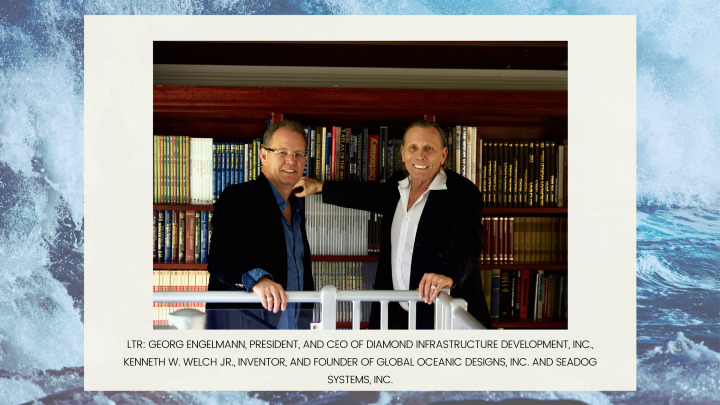
Mr. Welch, with his companies, has invested $3 to $5 million annually amounting to 10’s of millions over last two decades in the ideation, realization, modeling, testing, and demonstration of their wave energy technology, which was more recently independently assessed by Diamond Infrastructure Development, Inc. as a third-party evaluation, citing the companies’ technologies as economically feasible and ready for commercialization.
Now, partnering with the “Henosis Foundation”, a non-profit aimed at solving hunger, access to reliable and safe drinking water, and the elimination of poverty, sees a future in conjunction with Diamond Infrastructure Development, Inc. and their vision for global energy and water.
Working together toward the deployment of the Global Oceanic and SeaDog Systems energy technology suite, which provides a truly clean, recyclable, cold, grid-scale wave energy-driven hydropower system that works on the same order of economic and fiscal efficiency as hydroelectric dams, without the dam, the numerous environmental impacts of dams, or the disastrous consequences caused by large-scale dam failure.
The SeaDog Wave Pump is the centerpiece of SeaDog Systems, Inc.’s sustainable infrastructure technologies. It is a revolutionary wave-driven pump powered by the natural motions of waves and swells. SeaDog Wave pumps will use the up and down movement of the waves to power their enormous pumps. These pumps will then produce pressurized water that can be used for hundreds of applications, including to turn turbines that will produce electricity.
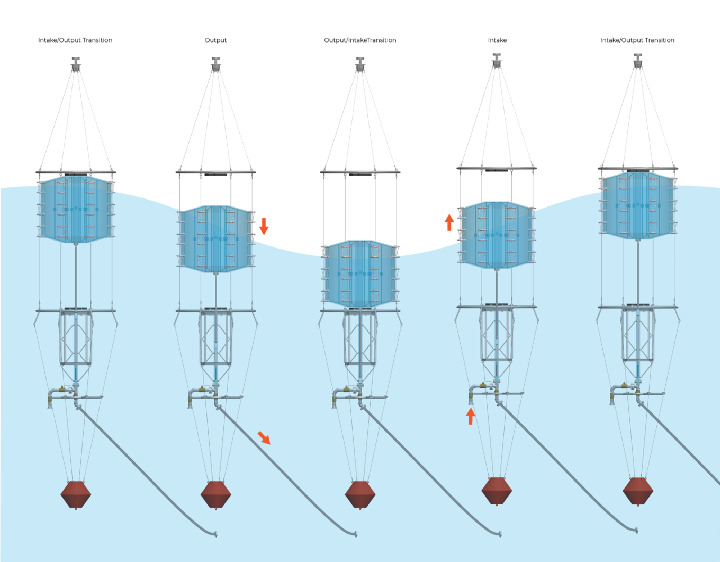
SeaDog’s wave pump design, as a carousel tower, can be easily deployed as an Omni-directional, 24 piston wave converter. It will cost per kW installed, ranging from $4,800 to $7,500, and will have an impressive 50+ years of service life. SeaDog Wave Carousels can produce over 100 times more energy per acre than wind turbines and with more than double the service life, making them more stable and cost-efficient.

The Wave Energy Converter Carousel can convert offshore wind turbine towers into a more cost-effective and sustainable grid-scale offshore energy farm. It does not take away and consume land and is non-destructive to ocean life. It avoids the many harmful impacts and associated costs detailed above in other so-called RE systems.
With capacity factor superiority and higher energy output than a wind turbine, as well as cheaper cost of infrastructure, maintenance, and greater longevity, along with its network architecture, will not have a need for costly peaking plants or energy storage systems.
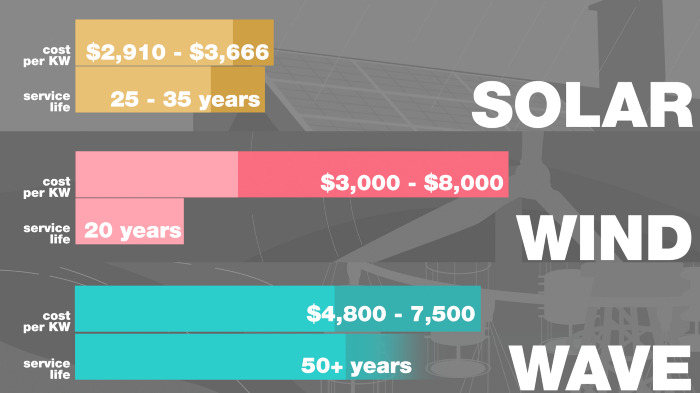
A Seadog Wave Energy Converter Carousel generates more energy than all other systems per given footprint. Making the SeaDog Wave Energy Converter a game-changer in wave energy development, designed to deal with the harshest of offshore environments. A truly disruptive technology on the leading edge of alternative energy breakthroughs.
“After our thorough research and along with our in-depth studies, it has become apparent that a program targeting the U.S. Atlantic Seaboard (the Wide-Open Wild West Ocean Frontier of the United States), it’s states, cities and towns would create the perfect first-model of alternative energy transformation across the wave energy sector providing for a positive impact on the U.S. Green Movement. The SeaDog Wave Energy Carousel, a nearshore wave energy system supporting shore-based desalination and hydroelectric power production, along with its offshore / shoreline network architecture, is the way forward.” Stated Mr. Welch Jr.
Mr. Engelmann added, “Our company has a suite of clean and sustainable energy technologies that will enable positive thrust and a differentiating position in the pumping of high-pressure seawater systems to impact the energy and desalination production markets globally.”
These high-pressure pumping systems can provide volumes of dedicated flows to a network of hydroelectric power plants onshore, or offshore, desalination systems on or offshore while providing a brine mixing discharge system neutralizing the toxic effects generated by such systems without the carbon footprint of today’s current programs.”
Their present efforts are focused on a blended program of energy and freshwater as a combined alternative energy sector, specifically targeting offshore wave energy in conjunction with seawater desalination and hydroelectric power and other related applications and services required in flourishing what they describe as a “Green World Movement,” offering additional grid-scale export energy for the local community at affordable pricing.
The power of America comes from boldly embracing new ideas and leading the charge for a better tomorrow. It’s time that leaders and stakeholders pay attention to the facts and invest in a system that will move our economy, people, and planet in a positive direction of growth and innovation through “Dam-free Hydropower” while stepping away from the control and deficit systems being presented currently in the alternative energy sector.
—
Media Contact: Hazel Rose, Diamond Infrastructure Development, +1 949 409 4700, press@decastellanecreative.com
Via KISS PR Distribution – Media Contact: Az@kisspr.com
Release ID: 226100













